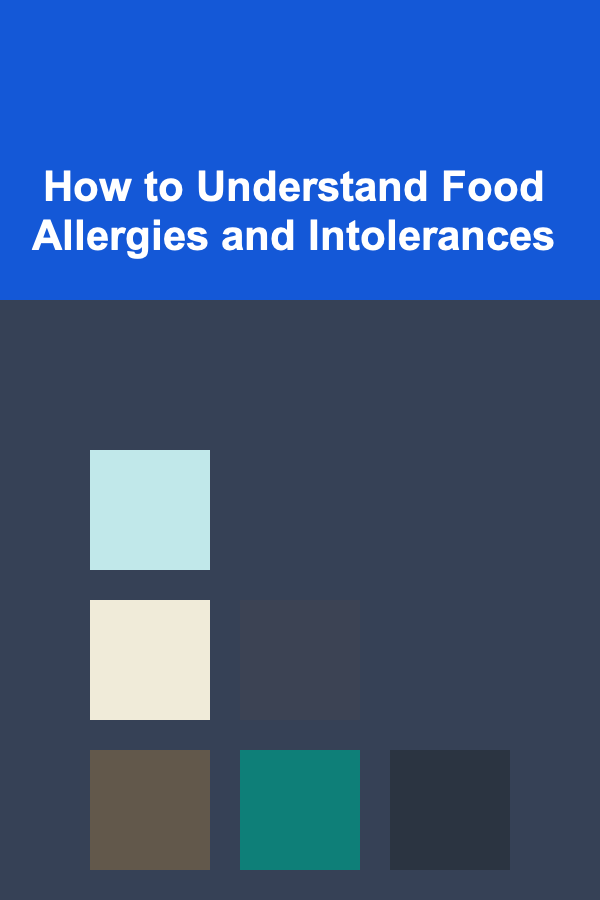
How to Understand Food Allergies and Intolerances
ebook include PDF & Audio bundle (Micro Guide)
$12.99$7.99
Limited Time Offer! Order within the next:

Food allergies and intolerances are common terms that often get used interchangeably, but they represent two distinct health issues. While both can cause discomfort or even severe health problems, the underlying causes, symptoms, and treatment methods vary significantly. Understanding the difference between food allergies and intolerances is critical to managing symptoms and ensuring better health outcomes. In this article, we will explore food allergies and intolerances in depth, including their causes, symptoms, diagnostic methods, treatment options, and how they affect daily life.
What Are Food Allergies?
Definition and Overview
Food allergies occur when the body's immune system mistakenly identifies a harmless food protein as a harmful substance. In response, the immune system triggers an allergic reaction, releasing chemicals like histamine to defend the body against what it perceives as a threat. These reactions can vary in severity, from mild symptoms like itching to life-threatening conditions such as anaphylaxis.
How Food Allergies Develop
The development of food allergies is a complex process involving genetic and environmental factors. A person's immune system typically learns to tolerate various substances during childhood, but in some cases, the immune system mistakenly identifies certain foods as harmful.
When the immune system reacts to a food protein, it produces antibodies known as Immunoglobulin E (IgE). These antibodies bind to the food proteins, which can cause the body to release histamine and other chemicals. The symptoms of food allergies can manifest within minutes to a few hours after exposure to the allergenic food.
Common Food Allergens
The most common food allergens are often referred to as the "Big 8" in the United States. These include:
- Peanuts: One of the most severe food allergens, peanut allergies can cause anaphylaxis in some individuals.
- Tree nuts: Including almonds, walnuts, and cashews, tree nuts are another leading cause of allergic reactions.
- Milk: Often seen in children, milk allergy occurs when the immune system reacts to proteins found in cow's milk.
- Eggs: Common in children, egg allergies can cause reactions to both the whites and yolks.
- Wheat: Wheat allergy is less common than some others but can still cause significant reactions.
- Soy: Soybeans are a frequent allergen in children and can cause gastrointestinal or skin reactions.
- Fish: Allergies to fish, such as salmon, tuna, or cod, are common and can trigger severe reactions.
- Shellfish: Crustaceans like shrimp, crab, and lobster are major triggers for allergic reactions.
Symptoms of Food Allergies
The symptoms of food allergies can range from mild to severe and may include:
- Skin reactions such as hives, eczema, or swelling
- Gastrointestinal symptoms like vomiting, diarrhea, or stomach cramps
- Respiratory symptoms like wheezing, coughing, or shortness of breath
- Swelling of the lips, tongue, or throat
- Anaphylaxis, a severe allergic reaction that can lead to shock, difficulty breathing, and even death if not treated immediately
Anaphylaxis: The Life-Threatening Reaction
Anaphylaxis is a severe allergic reaction that can be fatal if not treated promptly. Symptoms may include difficulty breathing, a rapid drop in blood pressure, and a loss of consciousness. Epinephrine, administered via an auto-injector, is the primary treatment for anaphylaxis and can save a person's life if given immediately.
Diagnosis of Food Allergies
To diagnose a food allergy, doctors typically begin with a thorough medical history and physical examination. Several tests can help confirm an allergy, including:
- Skin prick test: Small amounts of allergens are applied to the skin, and the area is pricked to allow the allergens to enter. If the person is allergic, they will develop a raised, red bump.
- Blood tests: Blood tests can measure the level of IgE antibodies specific to particular food proteins.
- Oral food challenge: Under medical supervision, a person consumes small amounts of the suspected allergen to see if a reaction occurs.
Treatment for Food Allergies
The primary treatment for food allergies is strict avoidance of the offending food. For individuals at risk of anaphylaxis, carrying an epinephrine auto-injector is essential in case of accidental exposure. In some cases, doctors may prescribe antihistamines to manage mild symptoms. However, there is currently no cure for food allergies, and prevention remains the best form of treatment.
What Are Food Intolerances?
Definition and Overview
Food intolerances occur when the body has difficulty digesting or processing certain foods. Unlike food allergies, food intolerances do not involve the immune system. Instead, they typically result from a deficiency in certain enzymes or sensitivities to specific food compounds, leading to discomfort or digestive issues.
Food intolerances are more common than food allergies and are usually less severe, although they can still affect quality of life. The symptoms of food intolerance are typically delayed and may take several hours to develop after consuming the problematic food.
Common Food Intolerances
The most common types of food intolerances include:
- Lactose intolerance: This occurs when the body is unable to break down lactose, a sugar found in dairy products. The body lacks lactase, the enzyme needed to digest lactose, leading to symptoms like bloating, gas, and diarrhea.
- Gluten intolerance: Also known as non-celiac gluten sensitivity, this condition occurs when the body reacts to gluten, a protein found in wheat, barley, and rye. Symptoms may include abdominal discomfort, bloating, and fatigue.
- Fructose intolerance: This occurs when the body cannot properly digest fructose, a sugar found in many fruits, vegetables, and processed foods.
- Histamine intolerance: Histamine is a compound found in fermented foods, certain vegetables, and alcoholic beverages. People with histamine intolerance experience symptoms such as headaches, rashes, and digestive issues when they consume foods high in histamine.
Symptoms of Food Intolerances
Unlike food allergies, the symptoms of food intolerances are often limited to the digestive system and include:
- Bloating
- Gas
- Stomach cramps
- Diarrhea
- Nausea
- Headaches (in some cases)
In most cases, food intolerances do not cause life-threatening reactions. However, they can lead to significant discomfort, especially when problematic foods are consumed in large quantities.
Diagnosis of Food Intolerances
Diagnosing food intolerances can be challenging, as symptoms may overlap with other conditions. A thorough medical history and a process of elimination are often used to pinpoint the offending food. In some cases, tests such as the hydrogen breath test for lactose intolerance or blood tests for celiac disease may be performed. However, the best way to diagnose a food intolerance is often through a food elimination diet, where suspected foods are removed from the diet for a period of time and then slowly reintroduced.
Treatment for Food Intolerances
Unlike food allergies, which require strict avoidance, food intolerances may be managed by reducing or eliminating the offending food from the diet. In some cases, individuals with lactose intolerance can tolerate small amounts of dairy or use lactase supplements to help digest lactose. Gluten-free diets are essential for individuals with celiac disease or severe gluten intolerance, but those with non-celiac gluten sensitivity may have more flexibility.
Food Allergies vs. Food Intolerances: Key Differences
While both food allergies and food intolerances can cause significant health problems, they are fundamentally different in terms of cause, severity, and treatment:
| Factor | Food Allergy | Food Intolerance | |---------------|---------------------------------------------------|----------------------------------------------------| | Cause | Immune system response to food protein | Difficulty digesting food due to enzyme deficiency | | Symptoms | Can include hives, swelling, anaphylaxis | Mostly digestive symptoms, like bloating and gas | | Severity | Can be life-threatening | Generally not life-threatening | | Diagnosis | Skin prick test, blood tests, oral food challenge | Elimination diet, hydrogen breath test | | Treatment | Strict avoidance, epinephrine for anaphylaxis | Avoidance or enzyme supplements |
Coping with Food Allergies and Intolerances
Living with food allergies or intolerances requires careful attention to dietary choices and, in some cases, lifestyle modifications. Here are some tips for coping:
1. Reading Labels
For individuals with food allergies, reading food labels is essential. Manufacturers are required to list common allergens, and avoiding processed foods or foods with ambiguous ingredients can prevent accidental exposure.
2. Avoiding Cross-Contamination
Cross-contamination can occur when foods containing allergens come into contact with safe foods. People with food allergies should take extra care when eating out or preparing food at home to prevent cross-contact.
3. Meal Planning
Meal planning is crucial for people with food intolerances or allergies. Preparing meals at home allows full control over ingredients, ensuring that no allergens or intolerant foods are included.
4. Seeking Medical Advice
If you suspect a food allergy or intolerance, consult with a healthcare provider. Proper diagnosis is key to managing your condition effectively.
Conclusion
Food allergies and intolerances can significantly impact a person's life, but with proper understanding and management, individuals can live healthy and fulfilling lives. Knowing the difference between allergies and intolerances, as well as understanding their symptoms, causes, and treatments, is essential for anyone affected by these conditions. By taking proactive steps, such as careful meal planning, reading labels, and seeking professional advice, individuals can minimize the impact of food-related health issues and enjoy a diverse and balanced diet.
Reading More From Our Other Websites
- [Gardening 101] How to Choose the Perfect Garden Book for Your Gardening Style
- [Organization Tip 101] How to Create a Family Command Center for Schedules
- [Organization Tip 101] How to Organize Fine China and Crystal Stemware
- [Personal Care Tips 101] How to Add Moisture to Your Skin with Body Wash
- [Personal Care Tips 101] How to Incorporate Face Masks into Your Daily Skincare Routine
- [Personal Care Tips 101] How to Switch to an Eco-Friendly Toothbrush for a Greener Smile
- [Hiking with Kids Tip 101] Best Trail Games and Scavenger Hunts That Teach Kids About Ecosystem Diversity
- [Organization Tip 101] How to Create a Personal Library at Home
- [Biking 101] Top 5 Bike Pumps Every Cyclist Should Have in Their Gear
- [Organization Tip 101] How to Set Up a Jewelry Repair Station at Home

How to Style Your Bathroom for the Holidays
Read More
How to Teach Your Children About Home Security
Read More
The Public Affairs Manager's Toolkit: Proven Methods for Managing Public Relations and Policy Initiatives
Read More
How To Style Asymmetrical Silhouettes
Read More
How To Master Fingerstyle Ukulele
Read More
How to Draw Manga and Anime Characters
Read MoreOther Products

How to Style Your Bathroom for the Holidays
Read More
How to Teach Your Children About Home Security
Read More
The Public Affairs Manager's Toolkit: Proven Methods for Managing Public Relations and Policy Initiatives
Read More
How To Style Asymmetrical Silhouettes
Read More
How To Master Fingerstyle Ukulele
Read More